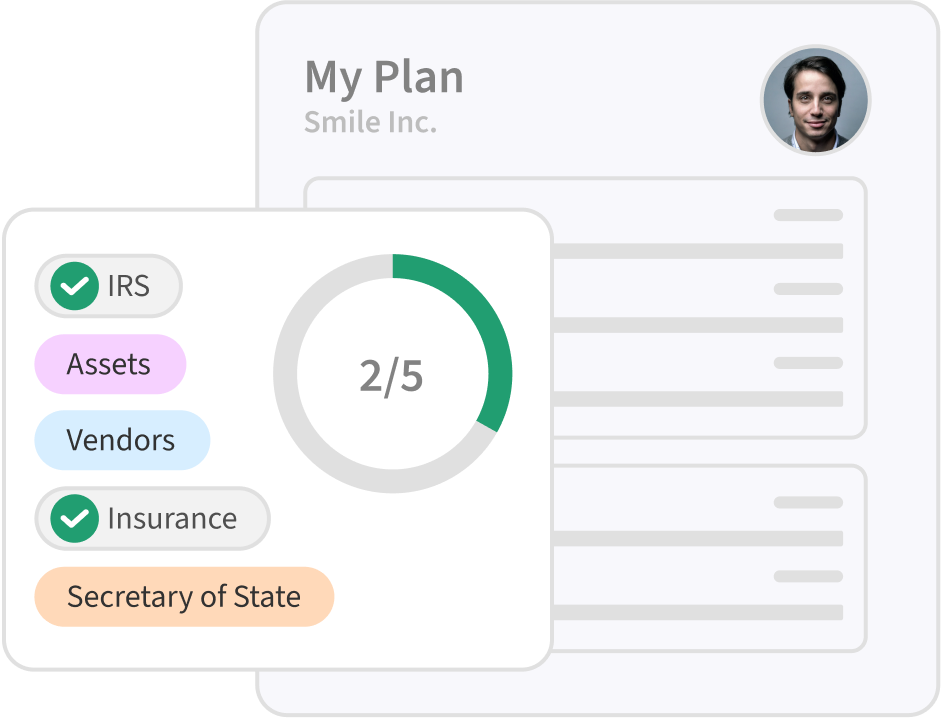We get it; shuttering your venture isn't just a logistical maze—it's emotionally draining too.
This blog provides a comprehensive guide to shutting down your company, featuring a closing down a business checklist with 6 easy-to-follow steps.
Key Takeaways
Once you close your company, it’s difficult, if not impossible, to come back. So, make sure your decision is final.
Inform your employees and customers well before you start the process and clearly communicate how things will look in the coming weeks.
Address your legal and financial obligations to prevent potential issues that could arise even after the dissolution date.
1. The Decision-Making Process
Despite the urge to re-pivot or hit the strategic drawing board, sometimes the most sensible decision is to close the business entirely.
As a sole proprietor, you decide when and how the closure happens. But for partnerships, corporations, and LLCs, all stakeholders need to be on board. The next step is determining whether you want to completely halt operations or formulate an exit business strategy (i.e., try to sell the business to interested buyers).
If the owners are not interested in selling the company, then businesses with physical inventory can limit financial losses by liquidating their equipment. Service-based agencies and software companies, however, need to consider a different strategy. In case of heavy debts, filing for bankruptcy may be on the cards – discuss things with your lawyer to select the best option.
Also, what about software development and SaaS-based companies? Well, shutdown for the former is relatively straightforward since their services revolve offer tailor-made solutions and there are no ‘product shutdown’ considerations as such.
However, for small and mid-tier SaaS-based companies, business closure should ideally be prolonged to give customers enough time to migrate to another solution. Doing so protects your reputation within the industry and maintains trust with customers should you try to re-engage in a similar business venture in the future.
Irrespective of your business structure or financial situation, once you initiate the closure process, it's often difficult—but not entirely impossible—to reverse things from here on out.
Various factors like legal filings, stakeholder agreements, and financial commitments made during the wind-down makes the process challenging to halt or undo.
2. How to Handle Internal Communications
Now comes the time when you must update all employees regarding the future of your company. The best way to proceed forward is to treat all employees fairly, with respect, and the honest truth.
Remember, your employees are adults and deserve to know things as they are. Tell them:
Why they are losing their job (quality or productivity issues, changes in technology, plummeting demand, inability to raise venture funding, etc.),
How the closure affects them (discuss severance benefits and outplacement support), and
What you will do to help them move forward and transition to their new jobs
Try to notify your employees as early as possible so that:
The news sink in, and they have time to mentally prepare for what’s to come
You can formulate a severance pay plan
You can help them look for a new role
Highlight how the last working days will look like and explain the closure process in detail to all staff members.
Note: Ensure compliance with all applicable local, state, and federal labor and employment laws. For example, some states obligate companies to pay employees the value of unused vacations before shutting down.
3. Inform Customers About the Imminent Shutdown
Like the last point, you’ll need to inform customers that your business is closing. You can issue a press release or publish a statement in the local newspaper if you're a medium-sized business owner. Then, break the news on all social media handles and your email/newsletter list (if you have one).
Be upfront and transparent with your customers – if you can’t fulfill ongoing contracts, negotiate an early termination. According to some contractual agreements, you may have to pay a cancellation fee. If you don’t have the funds to do so, contact your client and try to explain the situation.
If you operate a tech/software company with a subscription-based model, refund annual subscribers and turn off new signups and subscription renewals. Give users at least a month’s notice to export data (if such a feature exists) and look for alternatives.
Don’t forget to stop automated campaigns (e.g., Facebook and other pay-per-click ads) and remove marketing funnels (e.g., sales and landing pages promoting your product and/or services).
Convey your reasons for closing your business and reassure users that their data and privacy will remain safe.
4. Fulfill Your Legal and Financial Obligations
Taking care of your legal and financial obligations is crucial. It’s tempting to wrap things up and move on quickly, but it’s easier to claim outstanding account receivables while your company legally exists than as an individual (some companies may ignore your requests as you no longer own or are part of the company).
Plus, settling debts and fulfilling other financial obligations becomes easier with cash in hand (which is also your fiduciary duty). Reclaiming most of what others owe you will be an uphill task. Still, something is better than nothing, and you need all the finances you can muster during this time!
Here are some tips to increase your collections:
Do not announce your decision to close your company, especially to individuals/agencies who owe you money. Some may resort to delay tactics to push the process past the shutdown date.
Offer early payment discounts as an incentive.
Don’t solely rely on emails as means of notification; make calls and routinely follow up.
You will need to submit articles of dissolution with the state. The paperwork varies from state to state, but you can do so by reaching out to the Secretary of State’s office.
After paying your employees their last paycheck, terminating benefit & pension plans (if you offer any), and filing state and federal employment tax forms, it’s time to submit the Final Tax Return for the final year of your business.
Unpacking the filing and tax requirements for sole proprietors, partnerships, and corporations deserves its own blog. For now, visit IRS’ closing a business page for all the necessary details.
5. Tech-Specific Suggestions
Tech-specific closure practices include updating your website’s homepage with a blog post explaining your decision, preferably a few months before shutdown. Disable the automated renewals of your paid themes, plugins, and unsubscribe from collaborative software like Slack, Notion, Asana, etc., and other annual renewals like web hosting and domain name registration.
Note: Intellectual property like patents and trademarks are usually sold to settle outstanding debts or transferred in case of mergers or acquisitions
6. Wind Up Business Operations
After settling your debts and contracts, paying employees their due, and fulfilling your tax obligations, it’s time to file other relevant paperwork, some of which includes canceling:
Registrations, permits, and licenses.
Bank accounts
State tax accounts
Employer Identification Number (EIN) account
Leasing agreements
Credit cards
Rent & Utilities
Once complete, distribute the remaining cash and assets to the stakeholders according to their stake in the company.
But the work’s not done yet. As part of post-closure management practices, we highly recommend maintaining property records and – more importantly – employment tax records for at least four years.
Note: Some states forbid distributing assets to the owners if the company has yet to pay off its debts!
To Conclude
Let’s face it, shutting down sucks. At SimpleClosure, we leverage fintech, legal tech and AI, to simplify the wind-down process by automating the bureaucratic and manual work, giving founders - that’s you – the peace of mind needed to focus and get excited about your next project.
We also help reduce the time spent on this process from months and years to days and weeks, all while making sure it's done right!
If you want the same done for you, click here and let’s get talking!
Frequently Asked Questions
Got more questions related to business closure? Keep on reading!
What Should I Do with Assets When Closing a Business?
Liquidate inventory and sell assets when you decide to close a business. But you should only consider this move once you have settled outstanding debts and loans, issued the final payroll to employees, and fulfilled your tax obligations.
How Do I Tell My Staff I’m Closing the Business?
Once you’ve decided to shut down your business for good, inform employees about your decision. Be straightforward and let them know your reasons, but at the same time, be empathic and caring. Take responsibility and reassure them that you – and, by extension, the company they worked at – will try your best to help them look for and transition to a new job.

